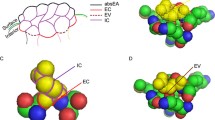Abstract
Protein antigenic determinants have been classified as continuous or discontinuous1,2. The continuous determinants are composed of residues which are local in the polypeptide sequence, while discontinuous determinants consist of residues from different parts of the sequence, brought together by the folding of the protein to its native structure. Searches made for protein determinants using peptide fragments which compete with protein–antibody complex formation, or peptides that can be used to raise antibodies which crossreact with the native protein, are limited to the simulation of continuous determinants. However, recent experiments2,3 suggest that most determinants are discontinuous. We now show, by consideration of protein surfaces, that if the recognition zone between a protein and antibody has the same dimensions as those found for the lysozyme–antibody complex4, none of the protein's surface will be ‘continuous’. We suggest that all determinants are discontinuous to some extent, and that crossreacting peptides mimic only the ‘primary’ interaction site. In addition, we show that the parts of a protein's surface which are most continuous fall predominantly in the loops and/or protruding regions. This explains why quantities such as hydrophilicity5, accessibility6, mobility7 and protrusion8 can be used to predict which parts of a polypeptide provide the ‘best’ antigenic peptides.
Similar content being viewed by others
References
Atassi, M. Z. Immunochemistry 12, 423–438 (1975).
Benjamin, D. C. et al. A. Rev. Immun. 2, 67–101 (1984).
Regenmortel, M. H. U. Hybridonia Technology in Agriculture and Veterinary Research (eds Stern, N. J. & Cramble, H. R.) Ch. 3 (Rowman & Allanheld, New Jersey, 1984).
Amit, A. G., Mariuzza, R. A., Philips, S. E. V. & Poljak, R. J. Nature 313, 156–158 (1985).
Hopp, T. P. & Woods, K. R. Proc. natn. Acad. Sci. U.S.A 78, 3824–3828 (1981).
Novotny, J. et al. Proc. natn. Acad. Sci. U.S.A 83, 226–230 (1986).
Westof, E. et al. Nature 311, 123–126 (1984).
Thornton, J. M., Edwards, M. S., Taylor, W. R. & Barlow, D. J. EMBO J. 5, 409–413 (1986).
Bernstein, F. C. et al. J. molec. Biol. 112, 535–542 (1977).
Lee, B. & Richards, F. M. J. molec. Biol. 55, 379–400 (1971).
Schulz, G. E. & Schirmer, R. H. Principles of Protein Structure Ch. 3 (Springer, New York, 1979).
Richards, F. A. Rev. Biophys. Bioengng 6, 151–176 (1977).
Atassi, M. Z. Eur. J. Biochem. 145, 1–20 (1985).
Ibrahimi, I. M., Eder, J., Prager, E. M., Wilson, A. C. & Araon, R. Molec. Immun. 17, 37–46 (1980).
Takagaki, Y., Hirayama, A., Fujio, H. & Amano, T. Biochemistry 19, 2498–2505 (1980).
Author information
Authors and Affiliations
Rights and permissions
About this article
Cite this article
Barlow, D., Edwards, M. & Thornton, J. Continuous and discontinuous protein antigenic determinants. Nature 322, 747–748 (1986). https://doi.org/10.1038/322747a0
Received:
Accepted:
Issue Date:
DOI: https://doi.org/10.1038/322747a0
- Springer Nature Limited
This article is cited by
-
Antigen epitopes of animal coronaviruses: a mini-review
Animal Diseases (2023)
-
In silico design of a polypeptide as a vaccine candidate against ascariasis
Scientific Reports (2023)
-
LBCE-XGB: A XGBoost Model for Predicting Linear B-Cell Epitopes Based on BERT Embeddings
Interdisciplinary Sciences: Computational Life Sciences (2023)
-
B cells oppose Mycoplasma pneumoniae vaccine enhanced disease and limit bacterial colonization of the lungs
npj Vaccines (2022)
-
Unconstrained generation of synthetic antibody–antigen structures to guide machine learning methodology for antibody specificity prediction
Nature Computational Science (2022)





